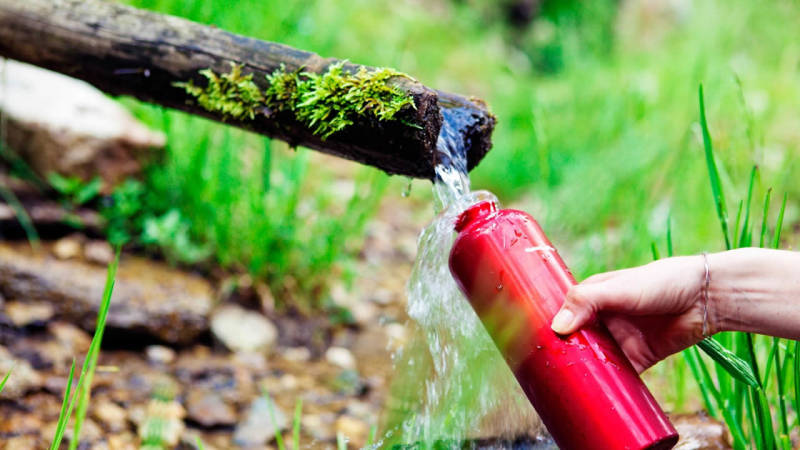
Finding, collecting, filtering and making drinkable water in the wilderness - the ultimate water guide
👉 The key facts from this guide
- Water is essential to life, and you can only survive for about three days without it. Therefore, finding and purifying water is one of the most important survival skills.
- There are various ways to find water in the wilderness, including flowing streams, dew, rainwater, dry riverbeds, beneath cliffs, marshes, swamps, tree hollows, fruits, and plants.
- To make the found water drinkable, you can boil it, chemically clean it, treat it with sunlight, distill it, or use a water filter.
- Boiling water is the safest method to kill all bacteria and parasites. However, it is also possible to clean water chemically or treat it with sunlight.
- Distilling water can also produce clean drinking water from seawater or urine. A self-built water filter can also be used if no fire is available.
- It is essential to always have enough drinkable water available, as dehydration can lead to serious health problems.
You probably know that you can only live three days without water.
Locating water is one of the most important survival skills.
The next significant step is making water drinkable.
In this article, you will learn everything about the precious commodity of water!
Fact: Water is essential for life
I asked over 100 survival enthusiasts which topic interested them and where they were keen to learn more, and the answer was: water and food.
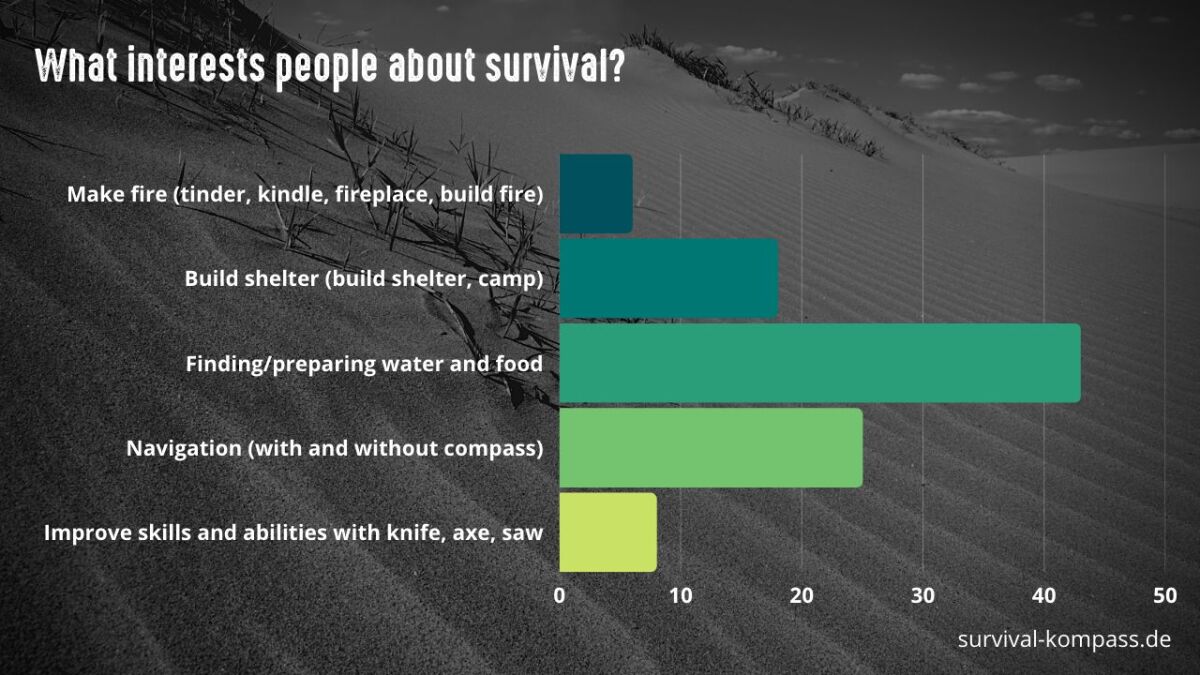
The fact is: going without drinking water for three days will leave you almost dead.
But don't underestimate the time before the third day.
You will already have massive problems after 24 hours without water.
It starts with dry lips, followed by circulatory issues, dizziness, and headaches.
When these symptoms start depends on temperature, climate, body mass, and your fitness.
If you don't drink anything, the following happens:
- With mild dehydration:
- Lack of saliva
- Less urine and excretion
- Dark color and strong smell of your urine
- With moderate dehydration:
- Even less urine
- Dry mouth
- Dry and sunken eyes
- Rapid heartbeat
- With severe dehydration:
- Lethargy and irritability
- Vomiting and diarrhea
The following happens inside your body:
- Your blood thickens, your organs are no longer optimally supplied with oxygen and nutrients
- Your kidneys cannot properly excrete toxins due to the lack of fluid, which returns to the bloodstream
- Your blood pressure drops rapidly, causing your skin to become cold and bluish-gray
- In the end, you die from shock and organ failure
Then you are dehydrated, which is one of your deadly enemies in a survival situation. You can read more about what happens during dehydration here or in my guide "Survival Time Without Water: How Long Can the Body Survive Without Fluid?".
Therefore, you must immediately begin looking for water in a survival situation.
Searching for water should always be your top priority. There is one exception: if it is cold, and you could be at risk of hypothermia, look for shelter first.
Once you have secured water and shelter, you can survive for weeks!
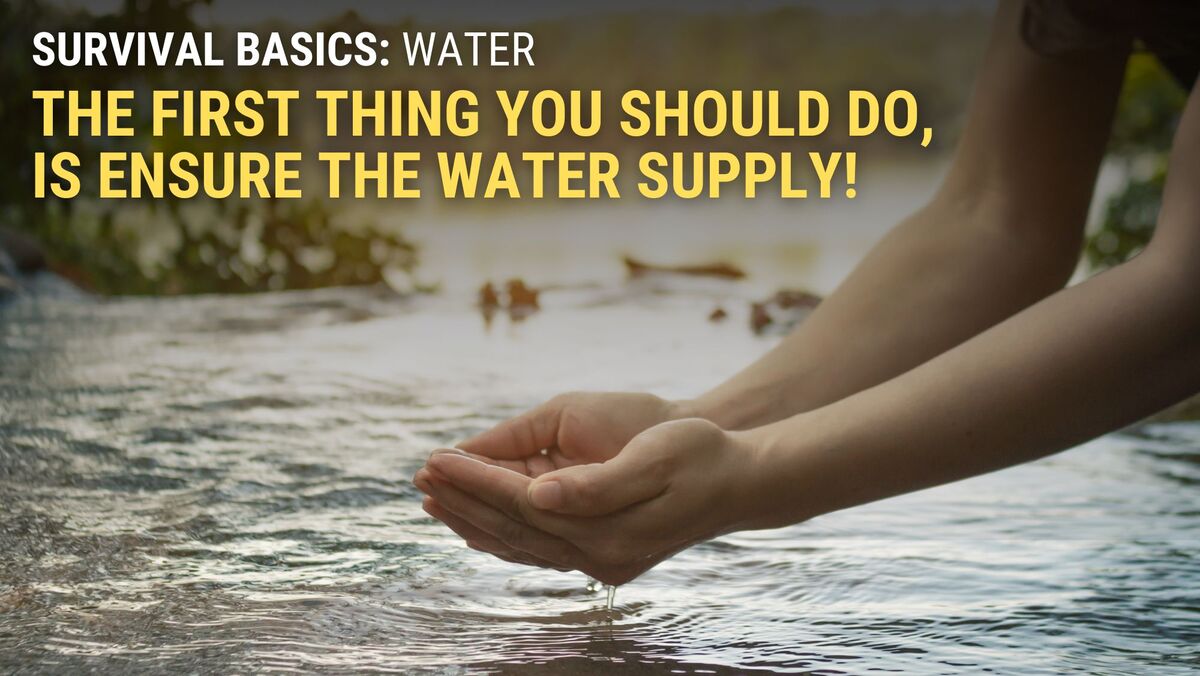
Reading tip: In my article "The most important survival tips for survival" you will find the ultimate points that you have to work through step by step in a survival situation. Additionally, I will tell you what the "Rule of Three" means. And in this guide article, I question the Rule of Three extensively.
How to find water
In Germany, you will probably quickly find a stream or river.
However, the situation is usually different in other countries and regions.
Now I will show you where and how to find water.
It is crucial that you then filter the water, which I will explain after the list.
Let's start!
Flowing bodies of water, such as rivers or streams
Flowing bodies of water are better than standing bodies of water, so get your water from there.
Check if a dead animal is nearby in the stream because then the water downstream of the dead animal is not drinkable.
Collecting dew water
In a climate zone where it is hot during the day and cold at night, dew often forms.
You collect this water with your t-shirt or something similar that absorbs the water - the main thing is that it is absorbent.
Then squeeze out the t-shirt and drink the water. Sucking on the wet t-shirt is also a way to get the liquid.

Here I have the right video for collecting water through dew:
Collecting rainwater
Rainwater is an excellent water source for your bushcraft camp.
To obtain it, you have to set up as many containers as possible in the rain.
Another way to collect even more water in the rain:
- Place your container
- Place many sticks in the container that protrude
- More water stays on the sticks and flows into the container
Make the comparison: Take a container without sticks and one with sticks. And you will see that the container with sticks contains much more water after five minutes of rain.
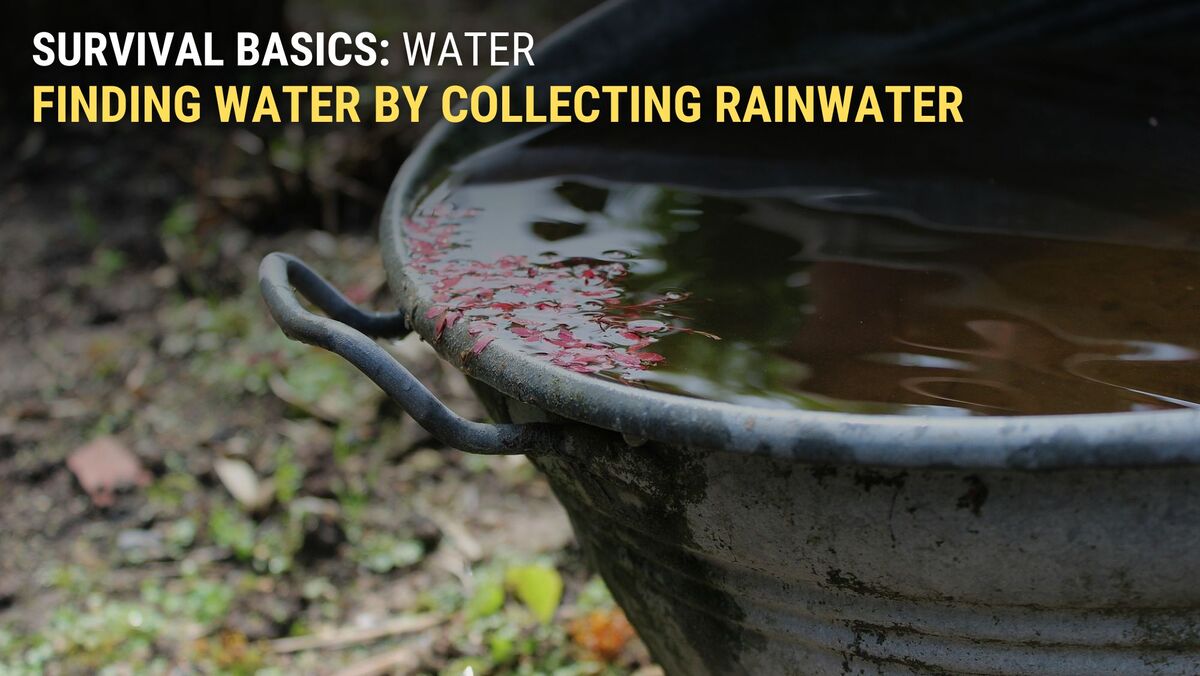
Also read my article "Is rainwater clean and drinkable?".
Dry riverbed
You typically find water in the stream bed of a dried-up river.
If there is still water there, you will find it at low-lying spots and the outer edge of bends.
If you see plants in the riverbed, this is also an indicator of water.
Dig for water at these spots. It can be hidden up to one meter deep.
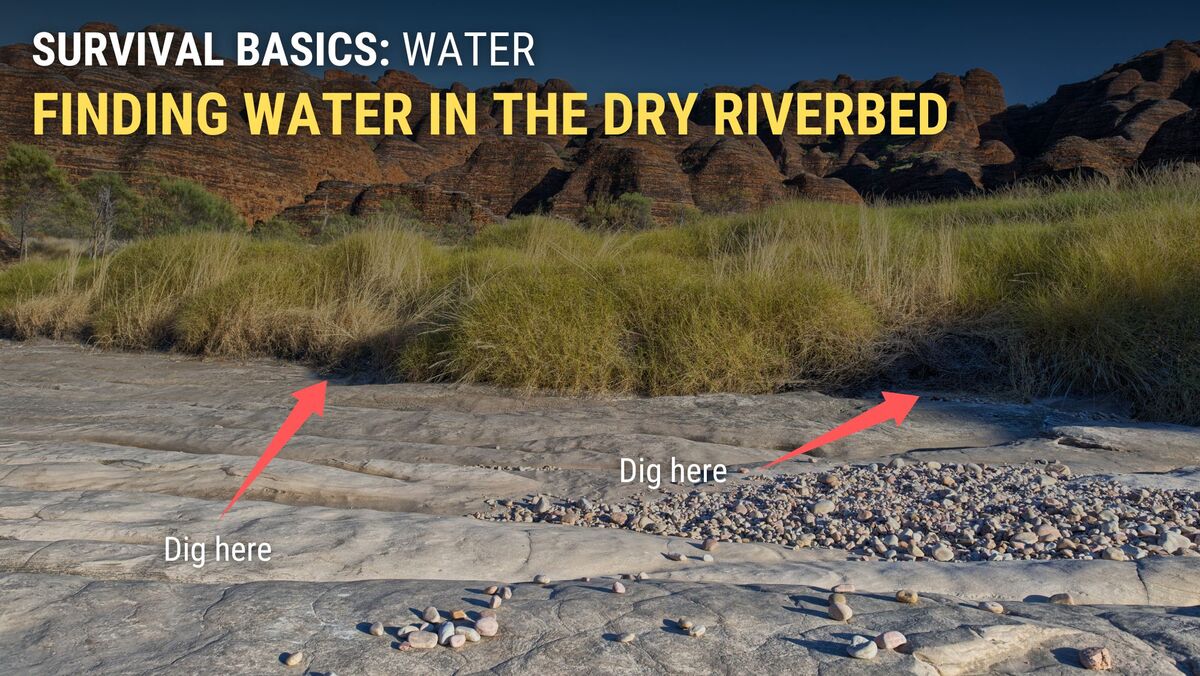
Beneath a cliff
Water accumulates on cliffs and hills. Go where the water flows.
If the spots are shady, there is a higher chance that you will find water there.
Dig for water at these spots and try your luck.
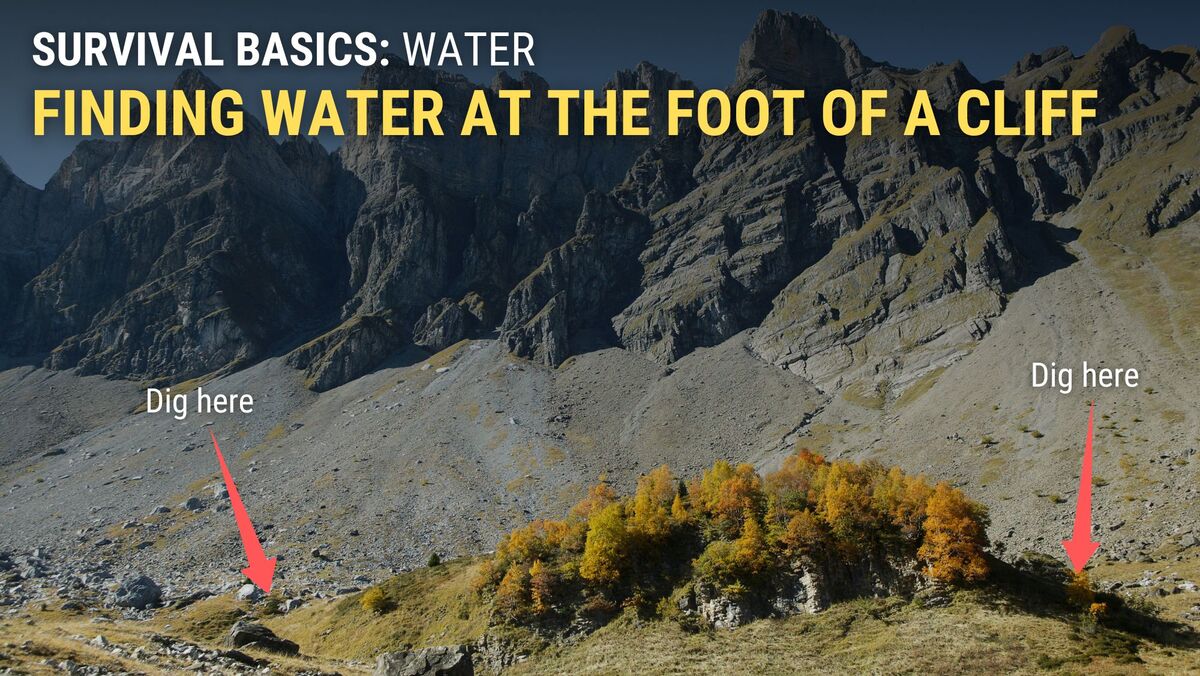
Bogs and swamps
In bogs and swamps, you can easily find drinking water because the groundwater softens the soil.
Dig a small hole, then wait and see if groundwater collects.
The layers of soil then filter the water - you can use this to your advantage.
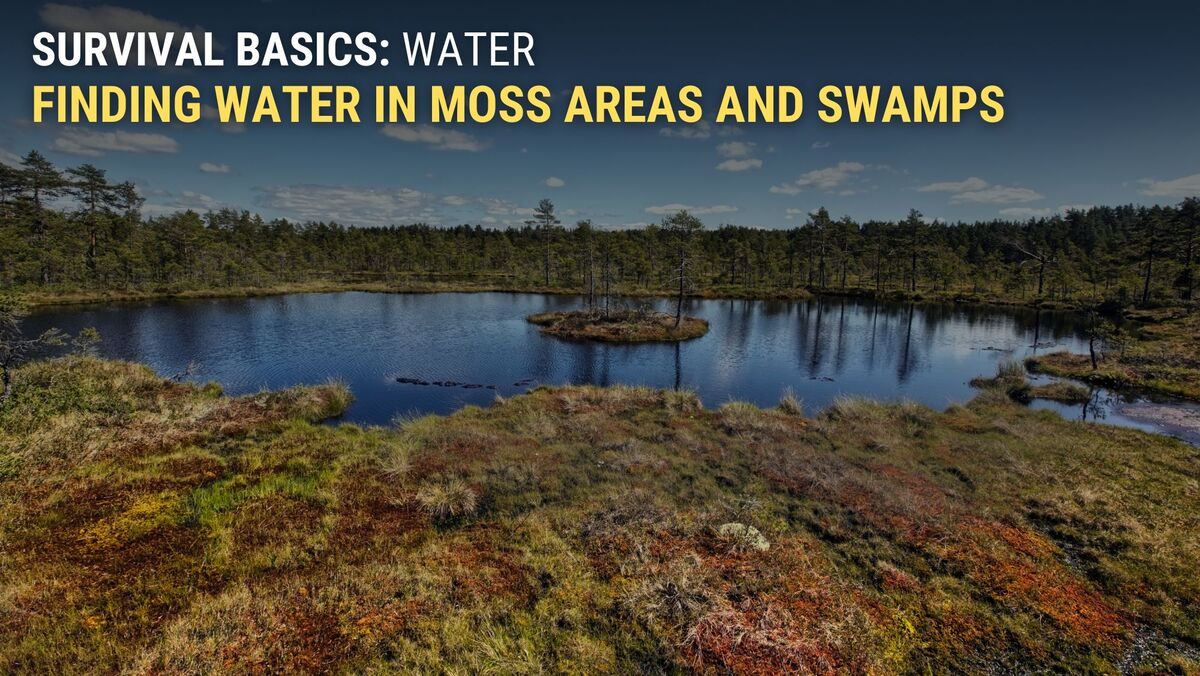
Tree Hollows
Water collects in hollows in tree branches after rain.
The water is usually inhabited by small organisms, so boil it before drinking.
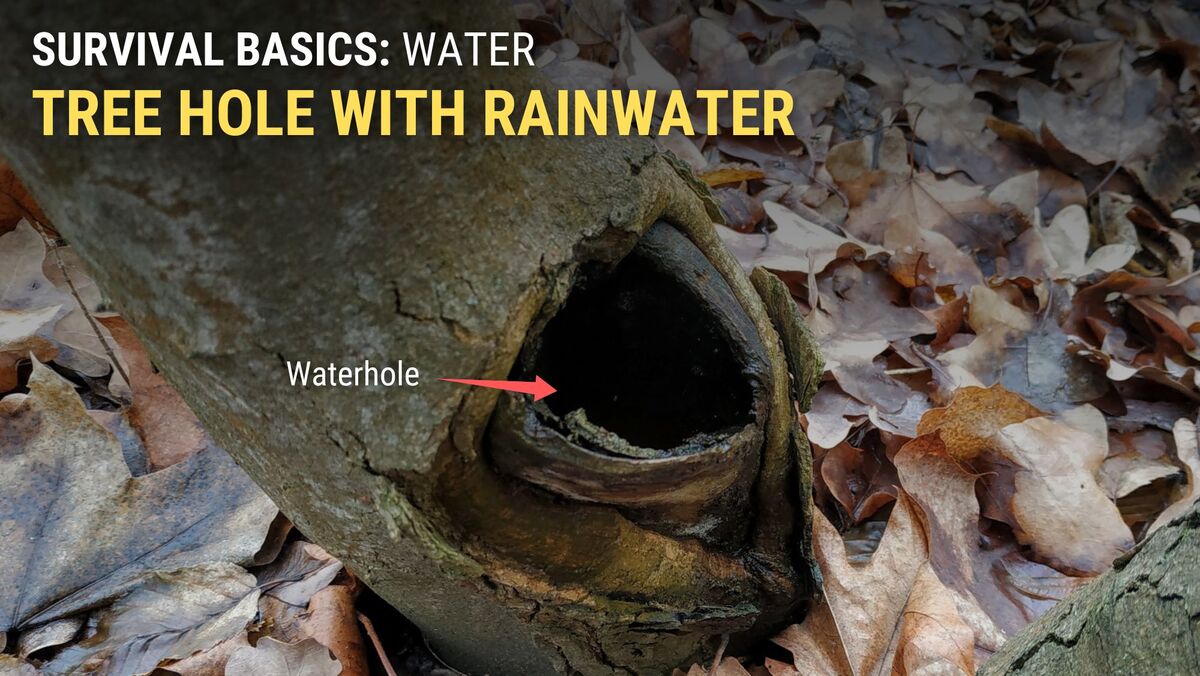
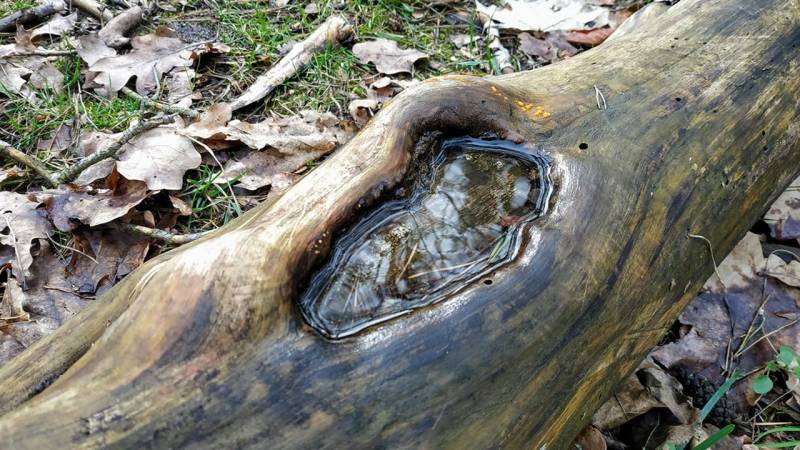
Fruits
Many fruits contain a good amount of water.
These include, in Germany: raspberries, blueberries, plums, strawberries, or apples.
In other countries, you can find coconuts as perfect water sources. But banana plants, green bamboo, and vines are also suitable.
Fruits also have the advantage that you can simultaneously take in food.
The perfect survival food!
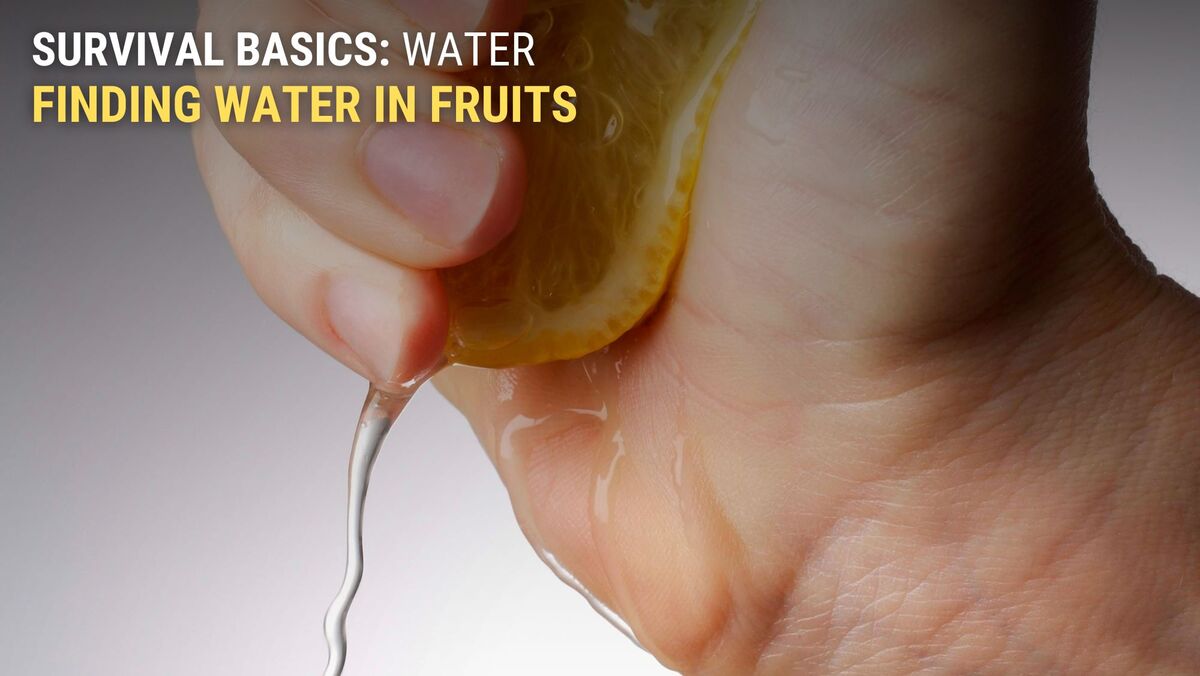
Extracting plant juice
Extract plant juice by squeezing them. Especially, plants with thick leaves have stored a lot of liquid.
The good thing is that plants purify the water from the ground. Therefore, you have relatively clean water available.
Depending on the plant species, the water can taste sour, sweet, or bitter, and it is also greenish.
However, make sure beforehand that it is not a poisonous plant.
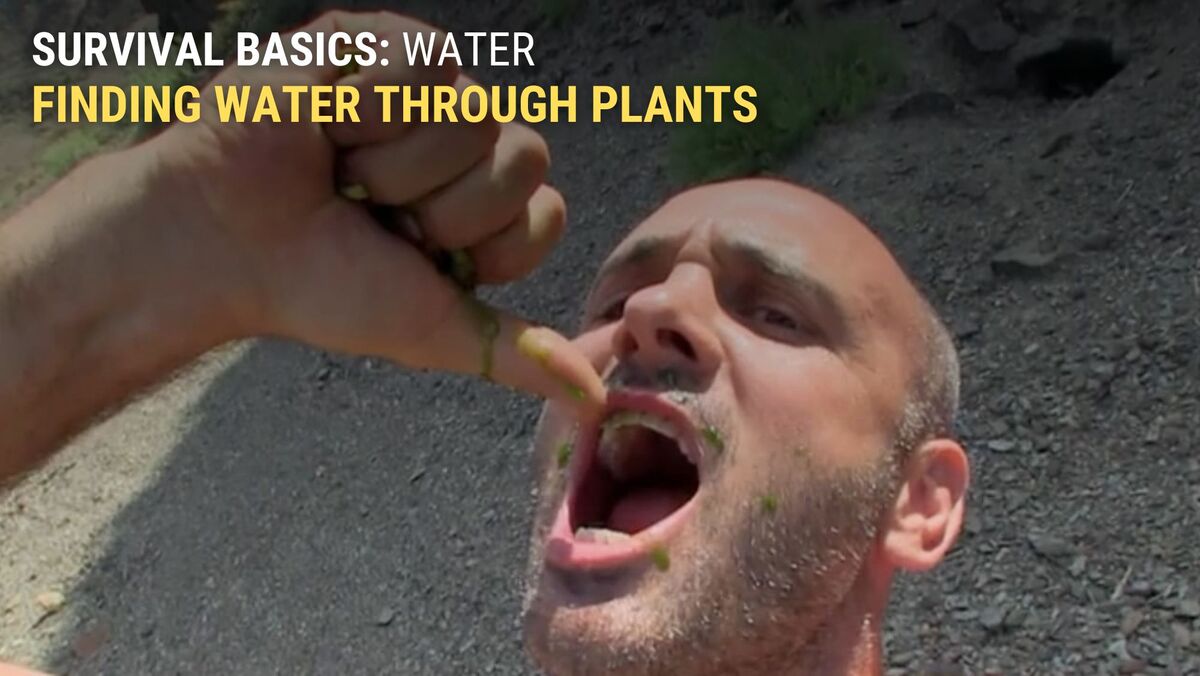
Insects, Animals, and Animal Tracks
If you find animals, you will find water nearby.
The basic rules for survival are:
- Bees: Water up to 4 km away
- Flies: Water up to 2 km away
- Mosquitoes: Water up to 500 m away
- Frogs: Water close by
Animal tracks can also lead you to water, as animals, like humans, need a regular supply of water.
Pay attention to the forks in animal paths. If two or more paths converge, follow that direction.
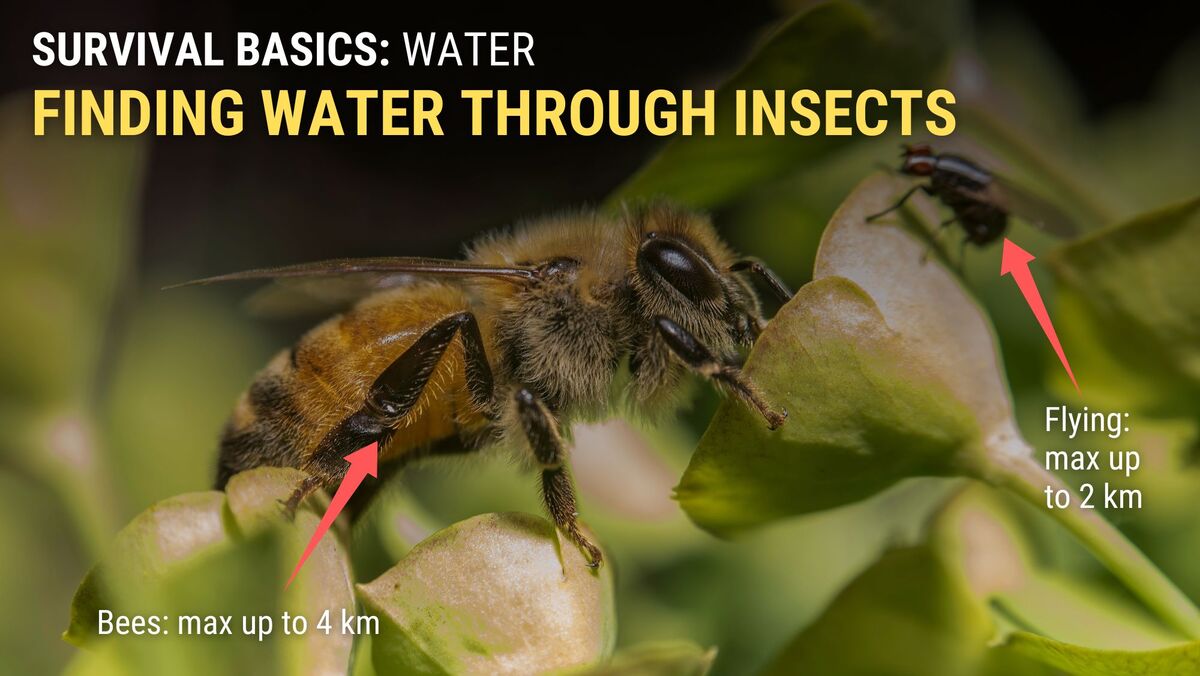
Recommended Reading: My article "Learning to Track for Beginners with Pictures and Examples" has many picture examples of animal tracks.
Beach
At the beach, you can build a beach well.
This is a hole that you dig behind the first dune from the sea. Dig about one meter deep.
The beach well collects the freshwater that seeps towards the sea.
Saltwater will also accumulate in the beach well.
Freshwater, however, is not as heavy as saltwater and therefore floats above the heavier saltwater.
If there is too much saltwater, then you should build a distillation from the pit. I will show you how to do this in my guide to water desalination.
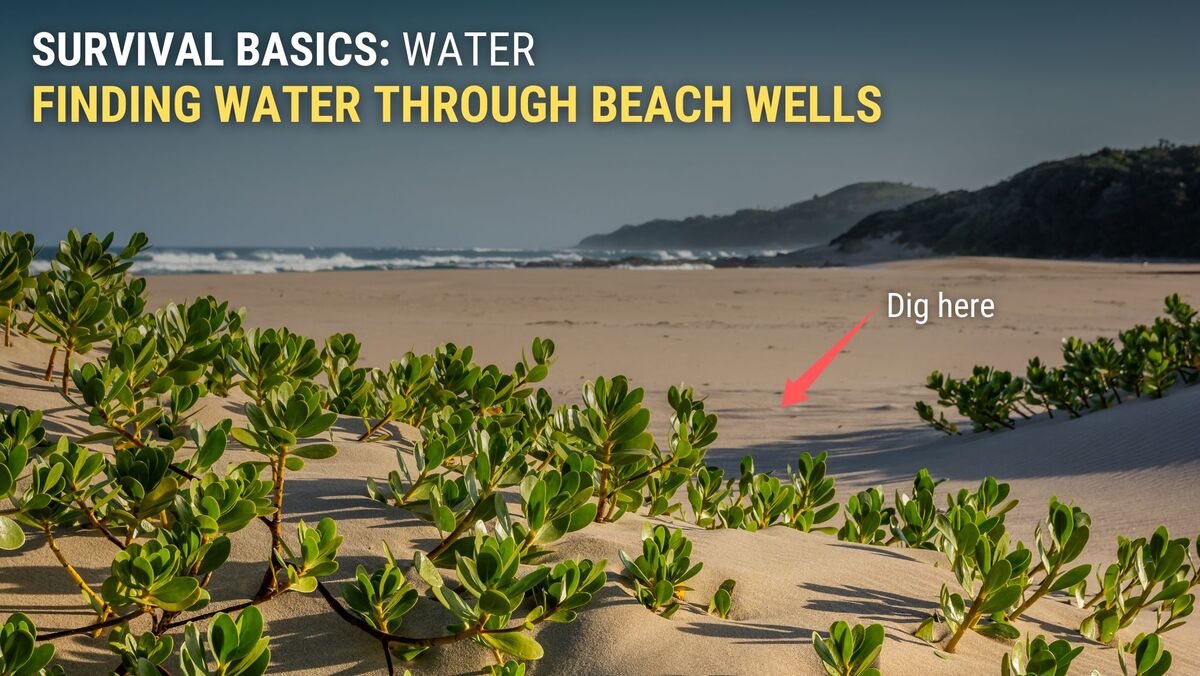
Transpiration
It is a basic and effective survival method for obtaining water in a dry environment.
For this method, you need a plastic bag.
- You tie the plastic bag around a heavily leafed branch of a tree or bush.
- Now let the sun shine on it for a few hours. The tree now "sweats" out the water.
- You will get approximately one cup of drinking water.
Tip: Put a stone in the plastic bag so that the water collects at the bottom. Or cut a small hole at the bottom and let the water drip into a container.
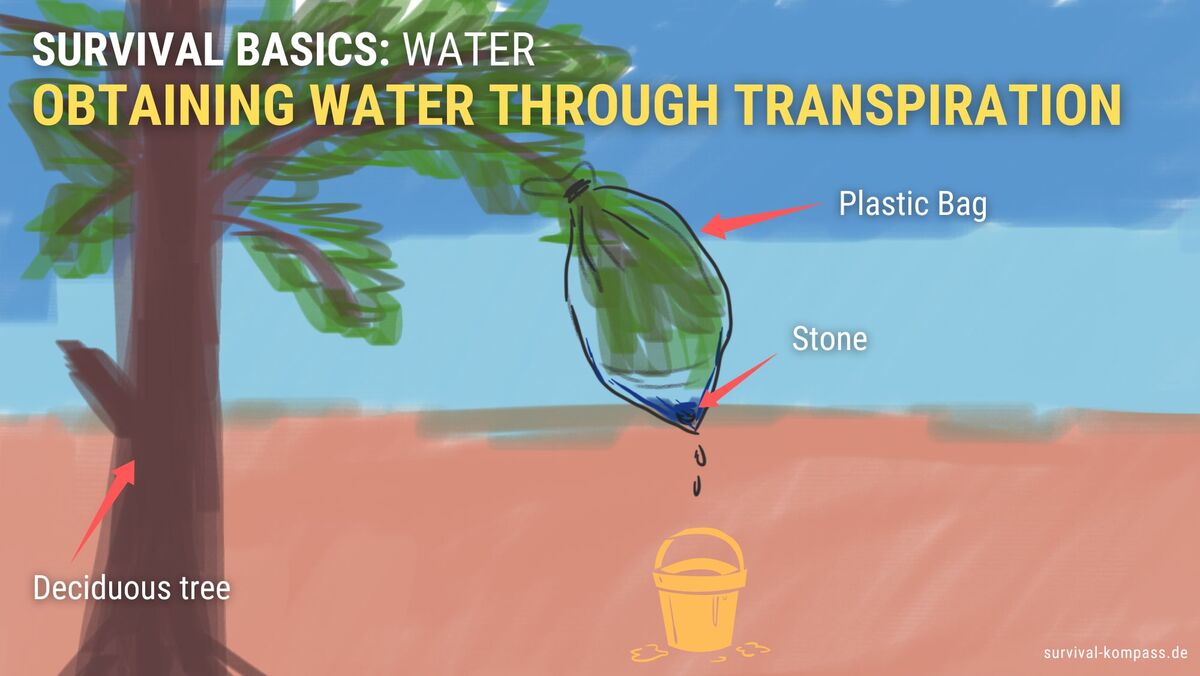
The same principle can also be applied to plants on the ground.
You just need to raise the middle of the plastic bag and set a deep point so that the condensation water from the plants collects there.
Find out more details about the great and simple method under "The Transpiration Bag: With this survival method, you can easily collect water in the wilderness".
Solar still
Here, too, you work with the transpiration of plants. A warm climate with lots of sun is perfect for this.
If you have a tarpaulin available, use this method to obtain drinking water.
- Dig a hole and place plants and leaves in it.
- Stretch the plastic sheet over the hole and weigh down the sheet with a stone in the middle.
- Place a container under the stone.
If the sheet is tightly sealed, the water vapor from the plants rises.
The water vapor condenses on the sheet and drips into the can.
Pro-tip: Lay a drinking tube from the outside into your container, so you can drink water at any time without dismantling your construction.

Making water drinkable through cleaning and filtering
To make the water, you have obtained drinkable, it is best to boil it.
In a survival situation, you cannot afford to have diarrhea or stomach pain.
Usually, you lose a lot more water through diseases than you can obtain quickly.
If you are dehydrated, you will not have the strength to collect fresh water.
Boiling water
With this method, you are 100% successful and make water drinkable.
When boiling, all bacteria and parasites die.
Let your water boil for at least 1–2 minutes. Thereafter, it is safe to drink.
I know that it is incredibly difficult to boil water in an extremely thirsty situation.
You have to make a fire and wait and wait.
In front of you, the water, you could go crazy and want to drink it all immediately.
But you have to restrain yourself and be patient.
I promise you: It is worth it because you have germ-free water and avoid getting diarrhea or vomiting.
If you don't have a pot, there are other ways to boil water.
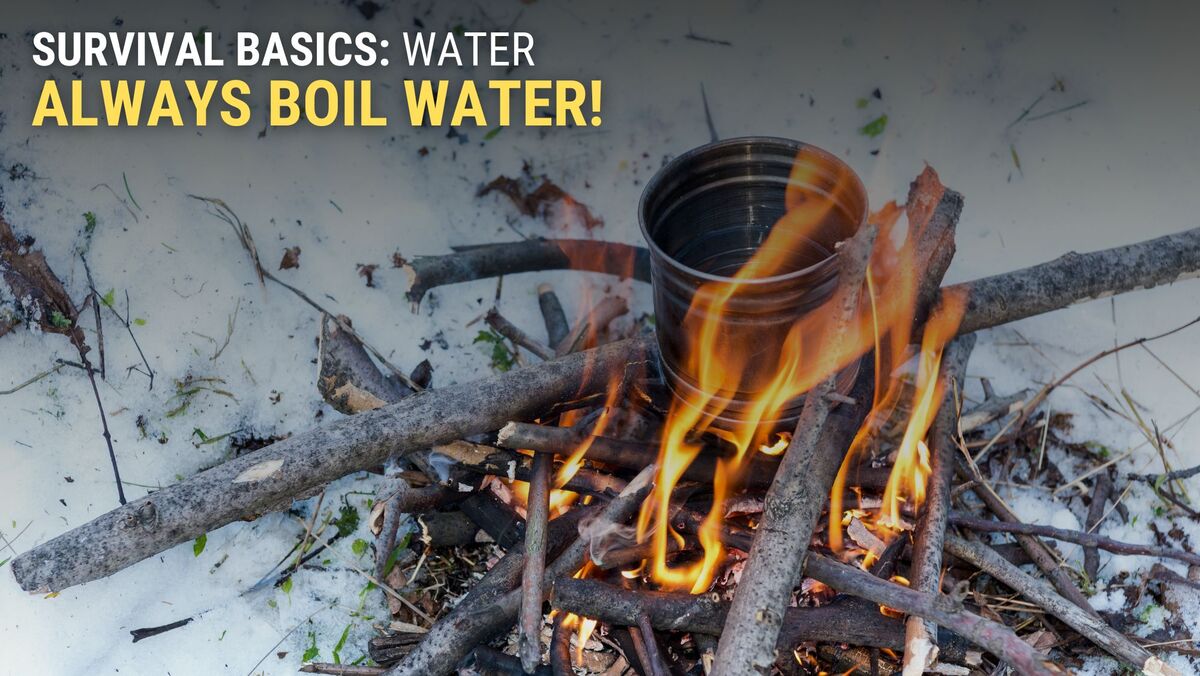
And if you don't have a pot with you, you might find an old PET bottle. And yes, you can also boil your water using a PET bottle in the campfire.
Chemically making water drinkable
Iodine, potassium permanganate, and chlorine can clean water in survival situations.
It takes time and the water usually tastes weird.
If you don't have fire, this is an alternative to boiling.
The most important thing is that you get drinkable water. Taste doesn't matter!
Here's a list of various tablets and powders for water treatment on Amazon.
Use sunlight to make water drinkable
The solar method kills bacteria in water using sunlight and UV rays.
All you need is a transparent PET bottle or a glass bottle.
Place the bottle in direct sunlight for at least six hours.
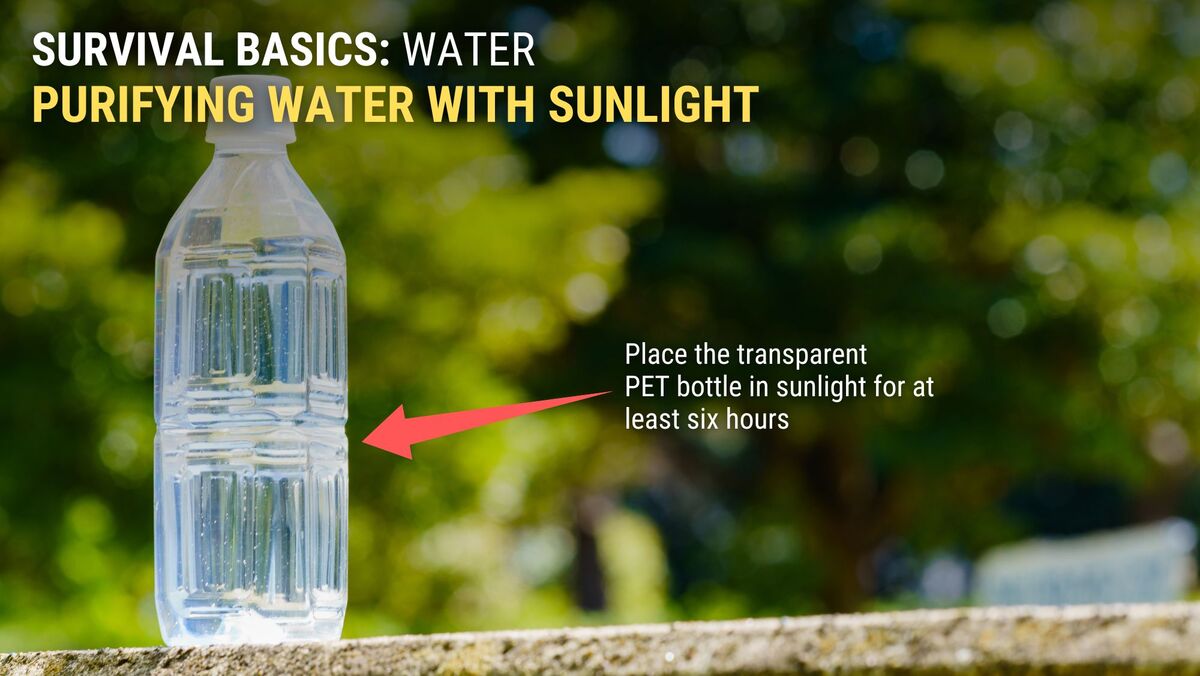
Distillation
Another way to produce fresh water is by distilling dirty water.
The method is more complicated, but has a big advantage.
You can also obtain clean drinking water from seawater or urine through distillation.
The water vapor is pulled through a tube, and the water collects in the second container.
However, you should never drink your urine!
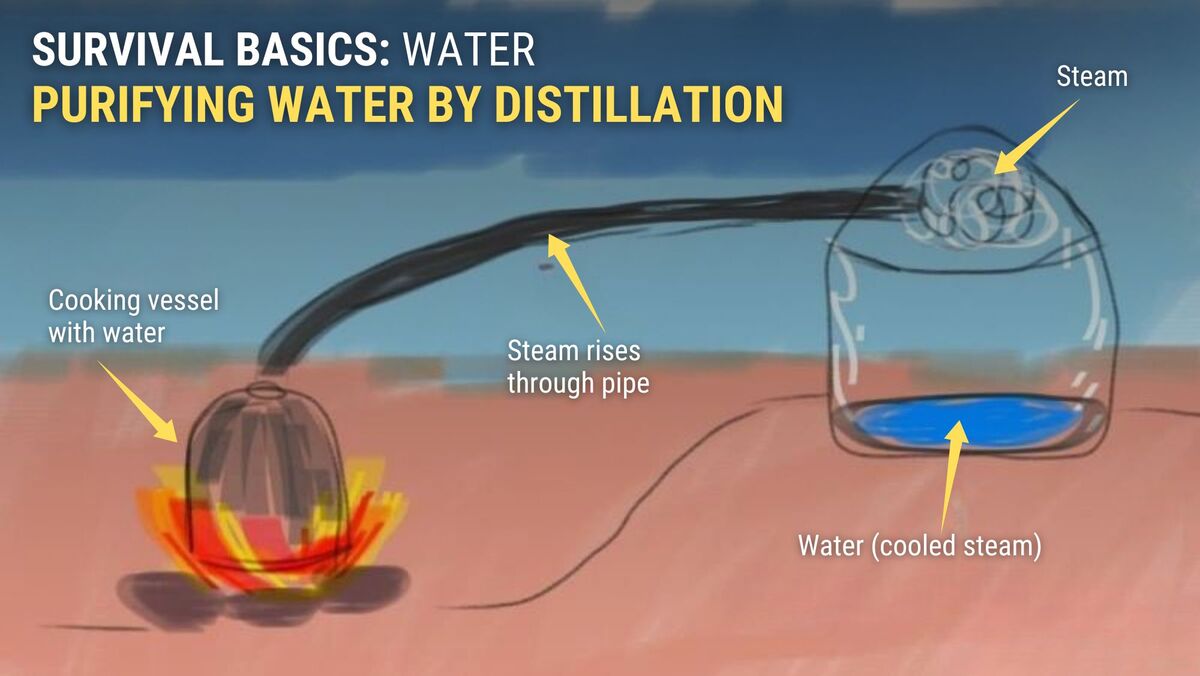
Build your own water filter
Building your own filter in the wilderness is possible, but be warned: it is difficult and requires practice.
A filter removes dirt and pathogens.
However, I recommend boiling the water afterward.
If you don't have a fire, then filtration is a suitable alternative.
In the picture, you can see how to set up your filter. If you don't have a bottle, use a pant leg or the sleeve of your shirt.
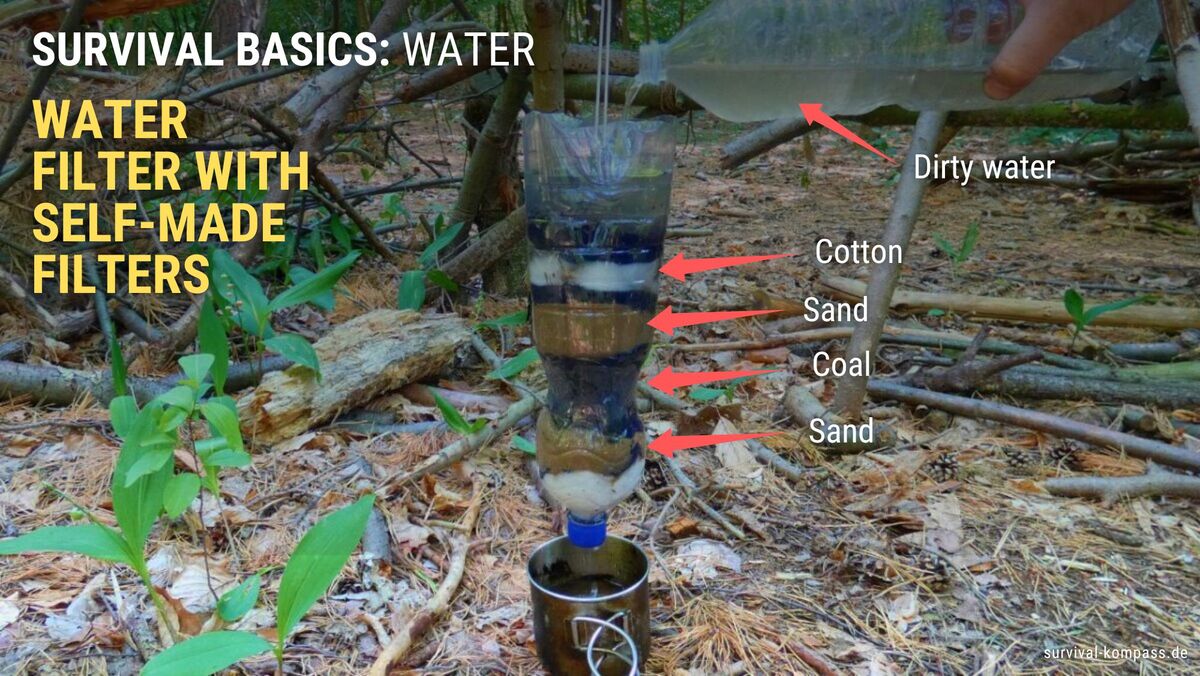
In my guide article "Build your own water filter [Survival Basics]" you will find detailed information about water filters.
Buying a water filter
If you want to be on the safe side, then buy a survival water filter.
In my opinion, this should be part of the basic equipment for a survival trip (Here I have written about everything concerning survival equipment).
You can simply hold it in the creek or lake and start drinking. It can't get any faster than that.
I always have my recommendation with me and even created my own review for it. Sure, it's not cheap, but the Katadyn Pocket Water Filter is a top-notch product.
And here you can find my top list of all water filters, if you are interested in other types.
Comparison of Water Treatment Methods
I would like to give you a brief overview of the water treatment methods. This way, you can see which methods are ideal and what they are useful for:
| Method | Removes bacteria | Removes viruses | Removes heavy metals | Removes chemicals | Special features |
|---|---|---|---|---|---|
| Boiling | Yes | Yes | No | No | Energy-intensive, but very safe |
| Homemade filter | No | No | No | No | Depends on filter quality |
| Water filter (industrially manufactured) | depending on product | depending on product | No | No | Depending on pore size, may also remove viruses or bacteria |
| Distillation | Yes | Yes | Yes | Mostly | Very complex, but the safest |
| UV light | Yes | Yes | No | No | Requires clear water and takes a long time |
Note: The safest method is the combination of filters (for suspended particles) and subsequent boiling (for pathogens).
Summary
This is my list for finding drinking water and making water drinkable for survival trips, bushcraft camps, or simply hiking.
Water is easy to find, especially in Germany. In unfamiliar regions, it is an entirely different challenge.
Especially in unfamiliar countries and situations, you must therefore prepare yourself particularly well for the search and treatment of water.
Always remember: Water is essential for survival. More important than a shelter, a fire, or food.
Now I would like to know from you if my list has helped you with your survival and bushcraft?
Or do you know of other ways to find and treat water?


Author of the guide
Martin Gebhardt
Hey, I'm Martin. On my blog, you will learn the basics and numerous details about living in the wild. I think survival, bushcraft and the good life in nature are the keys to happiness. Find me here on Instagram or on YouTube. You can find more about my mission on the About Me page.
Was this guide helpful?
150 people found this guide helpful.
4.97 out of 5 points (151 Ratings)
Comments (0)
This post may contain affiliate links. So if you click on the links and make a purchase, I will receive a small commission at no additional cost to you. Click here, to learn more about it.



